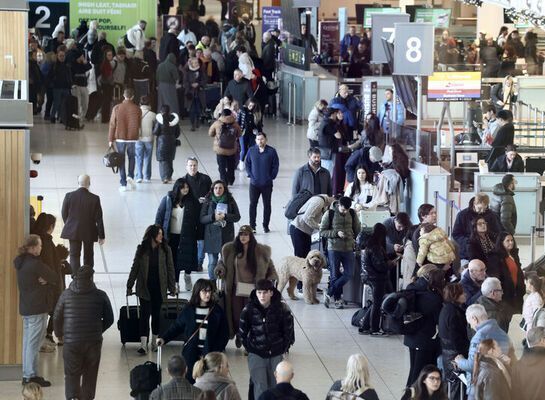A hundred years ago the economy in Belfast and its hinterland was booming led by shipbuilding and the burgeoning linen industry.
With help from the English establishment, these industries were controlled by the Protestant community in Northern Ireland. Employment for Catholics was largely confined to lower-paying jobs.Papists were deemed lazy and unreliable.
Loyalists believed that their dominance of industry was further proof of the superiority of their religion. God was on their side. From their perspective, Catholics, subservient to the Vatican, lacked ambition and industriousness.
They pointed to Dublin, a city in the economic doldrums where a good job in Guinness’ brewery – owned by a Protestant family – was a prized possession.
Edward Carson, the top Unionist leader, boasted that the new six-county statelet with a clear Protestant majority would “guarantee power in perpetuity” to loyalists.
All this balderdash talk about tribal superiority and Catholic abasement tied to phony biblical assumptions has far less acceptance in Northern Ireland today.
The reality is that the Republic of Ireland, firmly planted in the European Union, is recognized in Brussels as one of the most successful economies in the EU, while, unfortunately, the GDP in the North is seriously lagging compared to the Dublin resurgence.
In the past, unionists, cognizant of the significant benefits enjoyed by British citizens, liked to say about the nationalist community that they knew “which side their bread is buttered on.” By the same token Catholics frequently noted that the loyalist allegiance was less to the crown and more to the half-crown.
At the end of the 20th century, productivity levels were similar on both sides of the Border. Today, however, the Republic is performing 40% better. After allowing for cheaper prices in the North, household disposable income ends up 12% better in the South.
Recently, Alan Barrett, director of the Economic and Social Research Institute (ESRI) provided clear statistics about the performance of both economies north and south of the border. Today, the gross national income per capita is a whopping 51% higher in the Republic compared to the North.
At the end of the 20th century, productivity levels were similar on both sides of the Border. Today, however, the Republic is performing 40% better. After allowing for cheaper prices in the North, household disposable income ends up 12% better in the South.
Life expectancy, an important measure of progress in every country, began to favor the South around eighteen years ago. Now children born in the Republic can expect to live a year and a half longer than their cousins on the other side of the Border.
Karl Marx’s central economic insight pointed to standard of living issues as the main driving force in human thinking and behavior, or as James Carville used to say about the decisive determinant of elections, “it is the economy stupid.”
Of course, money and employment issues play an important part in every election, but it provides only one prism on issues that matter to voters.
Consider that many workers and retirees in America vote for the Republican Party, whose economic policies unabashedly favor the moneyed class.
The Trump budget passed during his tenure in the White House provided massive benefits to millionaires with very little of these borrowed trillions going to “ordinary” workers and struggling families. Polls show that these voters are very likely to continue their voting pattern in future elections. Clearly, they are motivated by non-monetary considerations.
The same dynamics apply in Northern Ireland. The dramatic changes in the economic status in the South has only a minimal impact on the unionist community’s attitude to unification.
Unionist attachment to Britain is rooted in history and culture. Their heroes go back to King William in the 17th century and the Ulster Volunteers 200 years later and whose raison d’etre was to reject any rule from Dublin.
It is noteworthy that in the 1950s, when the South was on its knees economically and post-World War Britain was thriving, that this superior performance did not change nationalist convictions. Most of them would vote for Irish unity, then or now.
What about Brexit? First and foremost, it was driven by an assertion of English nationalist pride, based on the strong residue of feelings of superiority passed on from colonial times. Leaving Europe has ushered in a time of economic disaster throughout the United Kingdom. In the North, post-Brexit, the measure of poverty hovers around 14.3% compared to 8.9% in the South.
In 2022 the ESRI published the first major comparative study of education and training systems, North and South. A key finding emerging from that study strongly suggests that levels of educational attainment in the North are lower than in the South.
At the upper end of the qualification’s spectrum, the proportion of people with third-level degrees is similar in both regions. However, Northern Ireland only has a very small proportion of young people, 10%, who finish a post-secondary, non-third level program, compared to the Republic where Post Leaving Certificate (PLC) course completions account for around 30%.
Early school-leaving, a major challenge for education planners in every country, is close to three times more likely in the North than in the South. The proportion of 16 to 24-year-olds in this category has swelled to 14% in Northern Ireland compared to 6% in the South.
The researchers also highlighted the success of the DEIS (Delivering Equality of Opportunity in Schools) program in the South which focuses on alleviating social inequalities and improving the learning outcomes for at-risk groups.
On the provision of healthcare services, Professor Barrett points out that there are more similarities between the two systems than is generally realized with waiting lists seen as a major problem in both jurisdictions but especially in the North where, according to this research, the number of people on line for medical treatment has “pulled away massively from the South and the remainder of the UK.”
The recent local government election results in the North showed a huge 8% growth in the Sinn Fein vote. The party's North leader, Michelle O’Neill, barely mentioned Irish unity during the campaign focusing instead on demands for re-constituting Stormont and improving services for the people.
Gerry O'Shea blogs at wemustbetalking.com








